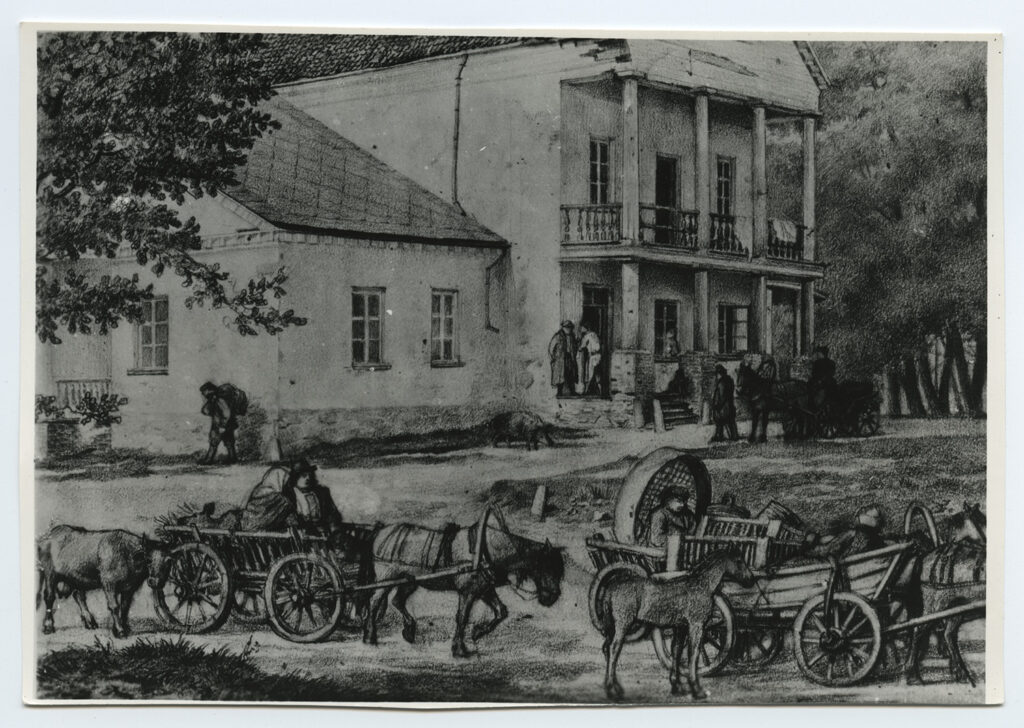KP18
EST:
Valge hobuse kõrts, Riia mnt 93
Karl Morgensterni (raamatukogu direktor 1802–1839) pikk reis Danzigist Tartusse algas 1802. aasta septembri lõpus, selleks ostetud tõllas, neli hobust ees. Otsekui hüvastijätuks märkas Morgenstern Danzigi ümbruses vaid parimat – kõikjal tugev pinnas, kraavitatud aasadel tugevad kariloomad ja talupoegade suur jõukus silmnähtavalt kaunites kodudes.
Tartusse jõudis Morgenstern 7. novembril. Linnaäärse postijaama aknast saadud esimese mulje pani ta kirja nukra tõdemusega, et siin viletsas provintsilinnas tuleb tal veeta oma parimad aastad. Seda meeldivam oli aga üllatus õhtul valgustatud linnasüdamesse jõudes.
Sama inglise keeles: A long journey from Danzig to Tartu started in the end of September 1802 in a chariot purchased for this purpose, four hired horses in front.
As if as goodbye, Morgenstern noticed only the best of Danzig’s surroundings – strong soil everywhere, sturdy cattle on the irrigated meadows, and the great wealth of the peasants indicated by their visibly beautiful homes.
Morgenstern arrived in Tartu on 7 November. he wrote his first impression in his diary, obtained when looking out through the window of a post office on the outskirts of town, with the sad remark, that he had to spend his best years here in a shabby provincial town. In light of this, reaching an illuminated city center in the evening was an ever more pleasant surprise.
Kui 1802. aastal sai Tartust taas ülikoolilinn, keelati keisri korraldusel siin avalikud teatrietendused. Karmi piirangut põhjendati väitega, et teater kütab üles niigi rahutute üliõpilaste meeled – etendustele järgnesid kaklused ja kokkupõrked politseiga.
19. sajandi algul oli Tartu linna piir praeguse Veski tänava kohal. Tamme linnaosas laiusid siis veel põllud, mis kuulusid Tamme karjamõisa alla, nii ka Novumi kõrts Riia postimaantee ääres. Tudengid ristisid selle Valge Hobuse kõrtsiks ning hakkasid käima siin suveteatris, mille näitleja Carl Theodor Nielitz 1857. aastal oli asutanud. Kõrtsi kõrvale, vanade pärnade alla ehitatud kerge teatrihoone mahutas 600 (!) istekohta. Novumi teater lõpetas oma tegevuse 1869. aastal, kerge teatriehitis Riia maantee ääres lammutati 1874. aastal.
Allikad
J. Anderson (koost.), Qui vult, potest: Karl Morgenstern 250. Tartu: Tartu Ülikooli Kirjastus, 2020; https://www.ester.ee/record=b5386802*est
E. Puusemp, Tähtvere mõisnik ehitas kõrtsi kõrvale teatri. – Tartu Postimees, 23.04.2001; https://tartu.postimees.ee/1863389/tahtvere-moisnik-ehitas-kortsi-korvale-teatri.Valge Hobuse kõrts. Vikipeedia; https://et.wikipedia.org/wiki/Valge_Hobuse_k%C3%B5rts

Fotokoopia Georg Friedrich Schlateri litograafiast. TÜ raamatukogu fotokogu
ENG:
White Horse Inn, Riia road 93
Karl Morgenstern’s (library director 1802–1839) long journey from Danzig to Tartu started at the end of September 1802 in a carriage purchased specifically for this purpose and driven by four hired horses. As he was leaving, Morgenstern saw only the best in the surrounds of Danzig – good soil everywhere, sturdy cattle on irrigated meadows and the prosperity of peasants demonstrated by their remarkably beautiful homes.
Morgenstern arrived in Tartu on 7 November. He noted down his first impressions from the window of the post-house on the outskirts of Tartu, with a sad remark that he was to spend the best years of his life in this shabby provincial town. He was pleasantly surprised in the evening when he arrived at the illuminated town centre.
When Tartu became a university town again in 1802, public theatre performances were banned here by the emperor’s order. The strict restrictions were explained as follows: the theatre would heat up the minds of students who were restless already – performances were followed by fights and clashes with the police.
Early in the 19th century, Tartu city border ran at the current Veski street. In the area of the current Tamme district, there were then fields of the Tamme manor farm and the Novum inn, which students started to call the White Horse Inn, by Riga road. Here, students also started to visit the summer theatre founded by actor Carl Theodor Nielitz in 1857. The theatre was a light structure under old lime trees right next to the inn and seated as many as 600 (!) people. The Novum theatre was closed in 1869, and the light-structure building by the Riga road was pulled down in 1874.
Sources
J. Anderson (koost.), Qui vult, potest: Karl Morgenstern 250. Tartu: Tartu Ülikooli Kirjastus, 2020; https://www.ester.ee/record=b5386802*est
E. Puusemp, Tähtvere mõisnik ehitas kõrtsi kõrvale teatri. – Tartu Postimees, 23.04.2001; https://tartu.postimees.ee/1863389/tahtvere-moisnik-ehitas-kortsi-korvale-teatri.Valge Hobuse kõrts. Vikipeedia; https://et.wikipedia.org/wiki/Valge_Hobuse_k%C3%B5rts

Photocopy of lithograph by Georg Friedrich Schlater. UT Library photo collection


